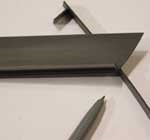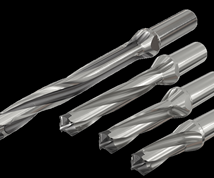The Graphite Link to Success
Graphite selection is the key to achieving optimum performance from the equipment on your shop floor.
Graphite is the material of choice for the majority of EDM electrodes produced today in the United States. Selecting the best grade of graphite for a particular application can be difficult if the differences between graphite grades are not understood. Depending on the graphite grade selected and the application, the graphite can be the limiting or the key factor in achieving the desired results from the equipment.
There is a wide range of grades from a number of manufacturers to choose from. Each manufacturer uses different processing techniques, source materials and process controls, which mean the end product, will be quite different. Each manufacturer's grades are designed for optimum performance for specific types of applications. To aid in material selection, each manufacturer publishes technical specifications on their material, but there are no standard test methods.
Featured Content
Since any grade of graphite looks similar to another grade, appearance is not part of the selection criteria. Each grade should be selected by its physical characteristics and properties. To make this process easier, various grades of graphite are grouped into six classifications that are segregated by average particle size. Only four of the six classifications are suitable for use as EDM electrodes. How the different grades rank within the classifications is an indicator of their performance potential.
Advances in Graphite
The graphite industry is constantly striving to produce higher quality grades. Graphite materials have continued to evolve along with the other aspects of the EDM industry, but at a less dramatic pace. Advancements have been made in the microstructure of the graphite materials, as this is the key to performance.
Coarse graphites with particle sizes over 100 microns have never been suitable as an electrode material. During the last decade, medium grades with a particles size between 21-100 microns have all but disappeared from the market as an EDM material. In the last few years many of the low-end grades within the fine classification (11-20 micron particle size materials) also have disappeared. The superfine classification (6-10 particle size) materials have remained stable. Some of the manufacturers of these materials allow their graphite grades to be sold as house brands, which can be confusing to the end user. Confusion occurs when consumable distributors change the names of their house brands, but still use the same material or change the material, but keep the same name for the house brand. The same grade may be offered under many house brand names.
The ultrafine classification (1-5 micron particle size) is where most of the real development efforts are targeted. Many of the plastic consumer products require molds with fine detail and finishes that can easily be achieved with ultrafine materials. Materials in this classification are very difficult and expensive to make and it is even more difficult to produce consistent material batch after batch and year after year.
There are very few grades in the angstrofine classification (< 1 micron particle size). The grades are available in small blocks to control the uniformity of the graphite. These grades are the most expensive to produce and have limited use. Generally, they are used for fine detailed engraving electrodes and small featured electrodes that produce very high surface finishes without the use of powder additives when polishing of cavities is not possible.
The lower end graphite grades are slowly disappearing from the market as EDM applications change. Large cavity mold work without fine detail and forging dies can easily be done by high-speed milling thus reducing the need for grades in the fine classification. At the same time intricate detailed cavity work requires graphite with small particle sizes, uniform microstructure and high strengths to produce complex, small-featured cavities.
Grades within Classifications
The physical properties of each grade of graphite determine the ranking within classifications. The properties that influence performance are particle size, flexural strength and shore hardness. These properties along with a photomicrograph of the microstructure are the best tools for predicting graphite performance.
The best graphite in any classification has tightly packed particles with little variation in size. This kind of uniform material resists wear caused by the thermal nature of the EDM process. Particle size is generally stated as an average size. When particle size spans a small range, the microstructure of the material becomes more uniform with reduced porosity. The porosity in the graphite is boundary between particles. The particles are bound together by chemical or mechanical means and the failure of this system is what releases particles into the gap when EDMing. If the material's particles are small, uniform in size and tightly packed, erosion of the electrode is minimal. Particle size has a bearing on the minimum surface finish that the material will produce. Since the electrode reproduces its structure in the cavity, fine surface finishes cannot be obtained with graphite grades that have large particle and non-uniform microstructure.
The microstructure of the graphite grade is often the limiting factor determining EDM performance. A non-uniform micro-structure with a wide range of particle and pore sizes can have soft spots that are large areas of porosity and/or hard spots which are conglomerates caused by inconsistent blending. Hard spots also can be caused by impregnating the open porosity of the material with pitch and then reprocessing the material giving the particles and pitch impregnated areas different hardness values. Since the unaided eye cannot see the microstructure, there is no way to detect these problems prior to the machining process. Identification of the cause of machining problems involves destructive testing and the examination of photomicrographs.
Graphite and High-Speed Machining
High-speed machining centers have made it possible to machine intricate detail into almost any grade of graphite, a task that would have been impossible using manual or CNC machining equipment. The high-speed spindles, making multiple passes with smaller chip loads, allow thin ribs to be machined without putting pressure on the rib. Materials with low compressive or flexural strength tend to break and chip while being machined into thin ribs on conventional equipment. These same materials can be machined on a high-speed machining center without problems. The ability of the machining center to put fine detail into almost any grade of graphite means the EDMer may have trouble producing the cavity if the appropriate graphite for the application was not used.
Graphites with inconsistent microstructures can produce problems that are more pronounced on a high-speed machining center. Hard spots in the graphite can cause the tool to deflect, resulting in an out-of-spec electrode. Material with hard spots is more likely to chip or break off during machining. When drilling there can be deflection off the surface of a hard spot and the hole may appear to be straight at the point of entry, but angled inside.
Soft spots, which are usually due to a very porous nature, can decrease the accuracy. The material may not have the strength to keep the tool straight. The cutter will often pull material out when it hits loose material. Chipping also is common. Machinists that regularly machine materials with this kind of microstructure learn to reduce feeds and speeds, thus increasing the machining time. All of these machining flaws can be detected on a CMM during inspection. If not corrected these flaws will be reproduced in the cavity.
Unlike metals that use the Rockwell method for measuring hardness, graphite hardness is reported by the Shore method. There is no cross-reference between the two measurement systems. Although hardness does not affect EDM performance, it will affect the machinability of the material. Graphites with a Shore hardness value of between 55 to 75 will be the most machinable materials.
Graphite and EDM Performance
EDMing thin ribs is a difficult application. High-speed machining of the elec-trodes has made it possible to fabricate these electrodes from grades that are not capable of maintaining the detail in the cavity. The ideal graphite grade for thin ribs should have a flexural strength above 10,000 psi. Materials that have these properties are normally found in the ultrafine classifications. Without adequate flexural strength, thin-ribbed electrodes can be deflected by flushing pressure or can break during orbiting. Graphite made of tightly packed small particles, will be able to resist erosion at the corners and edges of the electrode better than a material with large particles and pores. A thin ribbed electrode from material in the ultrafine classification can successfully complete the cavity, when the same electrode shape in a superfine or fine classification may crack or break during the cut.
Surface finish in the cavity is a mirror image of the surface of the electrode; therefore, grades with large particle and pore structure will not produce as fine a finish as small particle/pore size grades in the ultrafine classification. The operator can request a particular surface finish from the control menu and the operating parameters are adjusted to achieve that finish. If the graphite grade is not physically capable of producing the requested surface finish due to excessive porosity or particle size, the machine will continue to run without ever achieving the desired finish. When the proper grade of graphite is used for the electrode the desired surface finish can be obtained.
Decreased metal removal rates also can be a problem when the optimum grade of graphite is not used. Because the machine's sensors monitor the gap and adjust the machining parameters as necessary to maintain a stable cut, excessive or large particles in the gap will cause the ram to retract and advance slowly as cutting resumes. When there are excessive particles in the gap, it is due to high electrode wear.
Cost of Ownership
Graphite selection is the key to achieving optimum performance from the equipment on the shop floor. The equipment cannot run any faster than the quality of the graphite material allows it to run. Ultrafine graphites with uniform microstructures tend to be high-performance materials that allow aggressive settings to be used. Using these high-performance materials can trim hours off each operation and eliminate the waste caused by a graphite that has excessive wear, slow machine speed or failure in the tank. Understanding the capabilities of the graphite grade chosen for an application is critical to the EDM performance.
RELATED CONTENT
-
From CAM, Cutters and Cooling to Corrosion, Cleaning and Control
A review of the year’s top tips on technologies and strategies to improve moldmaking operations from design to first shot.
-
How to Produce More Accurate Molds and Reduce Rework
Patented micro-milling process for manufacturing steel plate flat and parallel helps mold builders shorten mold build times and increase accuracy.
-
How to Deal with Graphite Dust, Part 1
A review of the characteristics and considerations when handling graphite dust.















